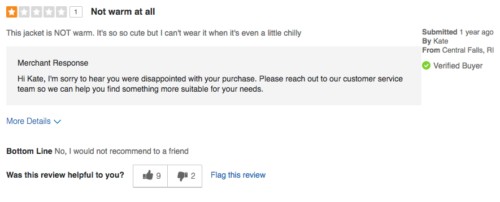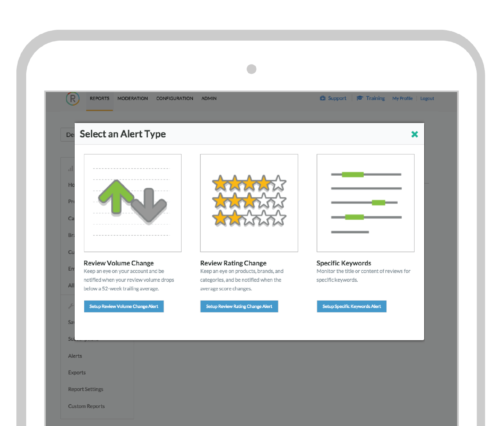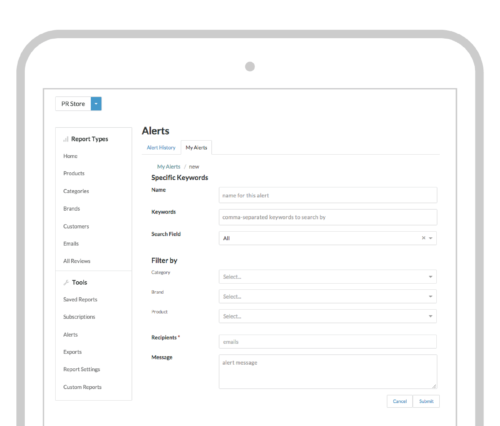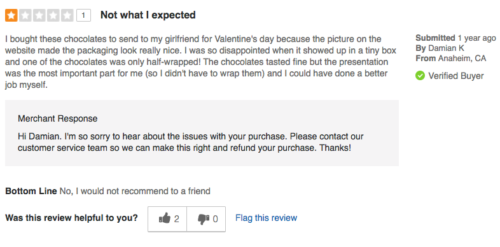Why Negative Reviews are Good for Your Bottom Line
The power of online reviews
In the not-so-distant past, when a consumer was in the market for a product, she’d ask for the opinions of her family and friends. And though traditional word of mouth is alive and well, increasingly, consumers are seeking out the opinions other consumers — by reading product reviews. In fact, 95% of consumers consult customer reviews prior to purchase. And in a recent PowerReviews survey, consumers ranked the presence of ratings and reviews as the most important factor affecting purchase decisions behind only the price of the product itself.
Why 5 star ratings aren’t the best
It may seem obvious that the higher a product’s average star rating, the more likely a person is to purchase it. And that’s true — up to a point. PowerReviews recently partnered with Northwestern University and found that purchase likelihood for a product actually peaks when the average star rating of a product is between 4.2 and 4.5 stars — and starts to drop as the star rating approaches a perfect 5. In other words, a shopper is more likely to purchase a product with an average star rating between 4.2 and 4.5 than one with a 5 star rating, likely because consumers perceive a perfect five star rating as “too good to be true.” In addition, our recent analysis of 7.8 million reviews in the PowerReviews network found that one-star reviews generate more “helpful” votes than any other star rating, on average. Why? Because in addition to adding a level of authenticity to your review content, negative reviews steer consumers towards products that best fit their needs.  Read on to learn more about why negative reviews are actually good for your business, and how to handle negative reviews if a customer leaves one. Who reads negative reviews? Why are negative reviews important for consumers? Reasons why negative reviews are important for businesses How to handle bad reviews How to respond to negative reviews Know when a response isn’t necessary
Read on to learn more about why negative reviews are actually good for your business, and how to handle negative reviews if a customer leaves one. Who reads negative reviews? Why are negative reviews important for consumers? Reasons why negative reviews are important for businesses How to handle bad reviews How to respond to negative reviews Know when a response isn’t necessary
Who reads negative reviews?
The majority of consumers read through negative reviews to validate their purchasing decisions. In fact, we know from previous research that 82% of consumers seek out negative reviews. For consumers under 45 years old, that number jumps to 86%. What’s more, 60% of Centennials (age 13 to 18) read negative reviews first. [bctt tweet=”60% of Centennials read negative reviews first.”]
Why are negative reviews important for consumers?
Negative reviews help consumers make smart purchase decisions, by letting them know everything about a potential purchase. Shoppers appreciate negative reviews and see them as an important element in their decision-making process, using them to hone in on the products that are right for them. In addition, it’s key to remember that one person’s negative might be completely irrelevant (or seen as a positive thing) to another person. For example, in the review below, a consumer gives a lip balm two stars. She mentions that she likes the formula of the lip balm, but the packaging is too bulky to fit in her pocket. A future shopper, who tends to store her lip balm in her purse, will find the negative comments irrelevant, and will proceed with the purchase.  Consumers consider not only the review, but also the reviewer. If the author of a negative review seems unlike the reader, the reader may discount the authenticity of the review for them personally. For example, a vacationer leaves a review for a resort he recently stayed at, and mentions there being lots of kids as a negative. But a consumer who plans to travel with her children actually sees this as a positive thing.
Consumers consider not only the review, but also the reviewer. If the author of a negative review seems unlike the reader, the reader may discount the authenticity of the review for them personally. For example, a vacationer leaves a review for a resort he recently stayed at, and mentions there being lots of kids as a negative. But a consumer who plans to travel with her children actually sees this as a positive thing.
Reasons why negative reviews are important for businesses
Establish Trust and Authenticity Displaying negative reviews on your site helps establish trust and authenticity with your customers. Seeing negative reviews assures consumers that the brand has nothing to hide, and therefore, is a brand that can be trusted. Consumers understand that a product can’t be all things to all people, and they appreciate negative reviews as an important element in their decision-making process. Increase sales Remember that the ideal star rating for a product is between 4.2 and 4.5 stars, and purchase likelihood starts to drop when a product’s average star rating reach a perfect 5. The occasional negative review gets your average star rating between 4.2 and 4.5 where purchase likelihood peaks. [bctt tweet=”The ideal star rating for a product is between 4.2 and 4.5 stars.”] Drive improvement and innovation Reviews — both positive and negative — are full of insights that can help you improve your products and your customers’ overall experience. If you’re not already, start monitoring what your customers are saying about your products, take their feedback into consideration, and pass it to the proper internal teams to guide improvements. For example, a PowerReviews customer had a watch on their ecommerce site with an average rating of 2.7 stars. The company took a closer look at their reviews and found that many customers commented that the clasp of the watch loosened after wearing it just a few times. The company worked with their manufacturer to improve the clasp, and the new version of the watch now has an average rating of 4.3 stars. Without reviews (especially the negative ones), this company may not have identified that the clasp was causing issues.
How to handle bad reviews
It might be tempting to delete a negative review, but don’t do it. Remember when we said that 82% of consumers read negative reviews? And 44% of Centennials wouldn’t trust product reviews if there aren’t any negative reviews present? By displaying negative reviews, you’re showing consumers that they can trust your brand because you have nothing to hide. When you respond to a negative review, you’re showing both the person who wrote the review — as well as future shoppers — that you truly care about your customers’ feedback. Make sure to monitor your reviews so you can quickly respond to one-star reviews, then leverage the feedback to improve products and the customer experience. If you’re a PowerReviews customer, make sure you’re taking advantage of our alerting capabilities. Set up alerts so you can quickly be notified when a specific keyword is used in a review or when there’s a significant drop in the number of reviews or average star rating you’re generating. 

How to respond to negative reviews
It’s a best practice to respond to negative reviews, to let your customers know their feedback is appreciated. Those customers will feel empowered and future shoppers will see that your brand cares about its customers.
Five Suggestions for effectively engaging with customers who leave bad reviews:
- Empathize with the customer’s frustration
- Thank the customer for their feedback and let them know that you value their input
- Provide a customer care phone number
- Offer to let the customer return the item for a refund or exchange
- Address a question or concern the customer has
Two Methods for responding to negative reviews:
Post a public reply Posting a response shows customers that you’re listening to them and that you value their feedback. Public replies are particularly useful when a product defect or feature has been (or is in the process of being) fixed.  Respond via email Another option for responding to a negative review is to email the reviewer directly. By directly reaching out to an unsatisfied customer, you are creating a more personal interaction and can quickly resolve issues while creating goodwill. The one downside of this option is that if you only respond to the customer directly, you are missing out on the opportunity for other customers to see your response.
Respond via email Another option for responding to a negative review is to email the reviewer directly. By directly reaching out to an unsatisfied customer, you are creating a more personal interaction and can quickly resolve issues while creating goodwill. The one downside of this option is that if you only respond to the customer directly, you are missing out on the opportunity for other customers to see your response.
Know when a response isn’t necessary
It’s beneficial to define a strategy around responding to negative (or positive) reviews on your site. While we recommend using this opportunity to address customers and acknowledge their feedback, it’s not necessary to respond to every negative review on your site. Understanding which reviews require a response, what your timing and solutions for a response will be, along with the response itself are all important components of a merchant response strategy.
Wrapping Up
Today, consumers have come to expect ratings and reviews when shopping for products in nearly every category. Brands and retailers need to prominently display ratings and reviews — both positive and negative — on their product pages, or risk losing customers to a competitor that provides this information. Rather than trying to silence negative reviews, start embracing them. 





 Respond via email
Respond via email 
